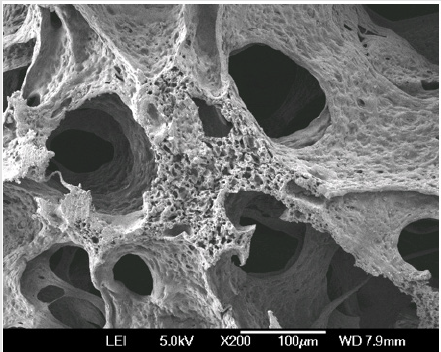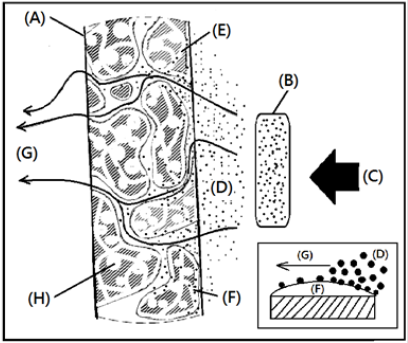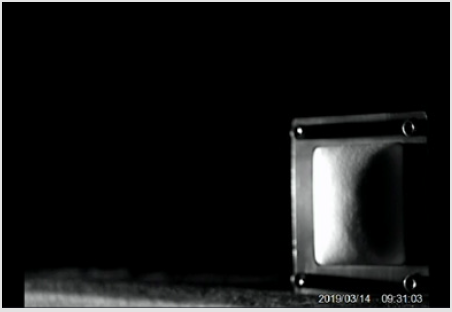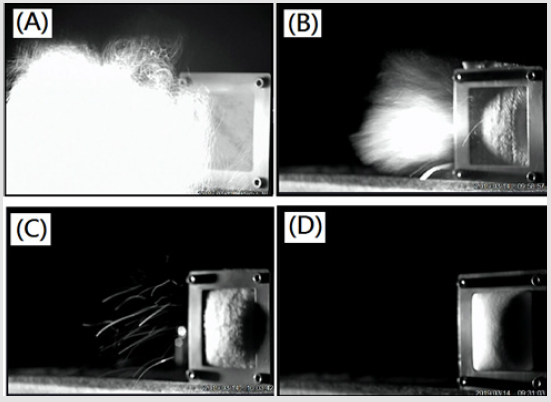Abstract
A novel nasal medical matrix derived from polyvinyl alcohol foam for protecting respiratory tract was designed and prepared. Further, evaluation and characteristics of the nasal medical matrix for protecting respiratory tract was carried out by using a designed microparticle- detecting system, which combined laser resources with low light sensors. A series of mmicroparticle-detecting images with high picture quality could be obtained even in a low light environment, which provide preclinic envidences for assistance of protecting respiratory tract.
Keywords: Polyvinyl Alcohol Foam; Laser; Respiratory Tract; Nasal
Abbreviations: PVA: Polyvinyl Alcohol; PU: Polyurethane; PNB: Polynorbornene; PMMA: Polyester Polymethacrylate Polyvinyl Alcohol Foam FTIR: Fourier Transform Infrared Spectroscopy
Introduction
The design of medical devices could be applied and developed
for new treatment procedures instead of the traditional therapy
procedures. For the demand of new clinic applications, selections
of suitable materials for biomedical and clinic applications such
as polyvinyl alcohol (PVA), polyurethane (PU), polynorbornene
(PNB), polyester, polymethacrylate (PMMA), natural polymer, and
polymeric resins could be substantially considered and further
employed [1-6]. The surface modification could be considered
to change the surface characteristic and microenvironment of
materials for specific clinic demand [7,8]. High permeability of
protecting medical matrix such as polyurethane (PU) matrix or
non-woven matrix could be employed for the clinic application
of masks. However, polyurethane or non-woven medical matrix
showed poor tissue anti-adhesion property, which would be a clinic
risk for wound managements. Polyvinyl alcohol showed well clinic
applications because of good cell or tissue anti-adhesion property
and high permeability no whether the matrix in the dried state or
in the wet state [9].
A design of novel nasal medical matrix derived from polyvinyl
alcohol foam for protecting respiratory tract was studied. Further,
evaluation and characteristics of the nasal medical matrix was
carried out by using a designed microparticle- detecting system,
which combined laser resources with low light sensors. A series of
mmicroparticle-detecting images with high picture quality would be
obtained to provide preclinic evidences of assistance for protecting
respiratory tract. In usual, the filtration film or filter membrane was
employed in the medical device or mask for protecting respiratory
tract. The filtration film or filter membrane could be a filtration layer or an absorption layer in the medical device or the mask or the
matrix. In this report, we propose a series of novel techniques and
medical devices for protecting respiratory tract. For the design of
new medical devices for protecting respiratory tract, selections of
suitable materials for clinical applications of protecting respiratory
tract such as ppolyvinyl alcohol foam or polyurethane foam were
substantially considered and employed [9]. Furthermore, the
biological and clinical evaluations of materials and medical devices
by using polyvinyl alcohol foam (PVAF) must be considered for
the application and design [9]. Preclinical evaluation of new
polyvinyl alcohol foam (PVAF) nasal matrix could be established by
determining penetrating microparticles, water permeability, and
macroporosityl property of resulting samples.
Methods
A novel nasal medical matrix with fully open cells and channels for protecting respiratory tract was designed by using a super clean air-foaming process. Polyvinyl alcohol (PVA) foam dressing could be considered as a good anti-adhesion material for protecting respiratory tract. An anti-adhesion foam nasal matrix with good mechanical and adsorption properties would be a potential medical matrix for protecting respiratory tract. Morphology and characteristics of the resulting polyvinyl alcohol foam (PVAF) matrix could be determined by using Fourier transform infrared spectroscopy (FTIR, Spectrum GX, USA) and Scanning electron microscopy (SEM, JSM 6700F, Japan).
A new microparticle-detecting system was designed by using some key modules such as a laser resource of 532 nm, an optical sensor photomultiplier, an image processing system, an optical scattering wall, a limiting module, and a mmicroparticles supply system to build up a new way for ppreclinical evaluation of protecting respiratory tract. Also, ppreclinical evaluation of the medical matrix by using the designed microparticle-detecting system, which combined laser resources with low light sensors.
Result and Discussion
In this study, a novel nasal medical matrix derived from polyvinyl alcohol foam for protecting respiratory tract was designed. The Morphology of designed cross-linked polyvinyl alcohol complex foam dressings with fully open-cell and openchannel microstructures was observed in the results of scanning electron microscopy as shown in Figure 1. The FTIR spectrum of novel nasal medical matrix derived from PVA foam can be observed a broad peak at 3302 cm-1 indicating stretching of hydroxyl groups (–OH) and peaks at 2982 cm-1 2881 cm-1 are due to –C-H stretching vibration. The peak at 1131 cm-1 suggested the presence of hydroxymethyl group(–CHOH). The peaks at 104 cm-1 and 919 cm-1 showed C-O stretching vibration of secondary alcohol and O-H bend respectively. The peak at 1487 cm-1 was contributed to –CH2 scissoring and the peak at 1341 cm-1 was contributed to –OH bending vibration.
Figure 1: Scanning electron microscopy of the designed nasal medical matrix derived from polyvinyl alcohol foam for protecting respiratory tract.
The nasal medical matrix derived from polyvinyl alcohol foam could be employed for protecting respiratory tract because of surface adsorption of water films on the microchannel ‘s and microcell’s surfaces as illustrated in Figure 2. When the air supply (Figure 2A-C) provides an air flow (Figure 2D-G) through a microparticles storage (Figure 2B), the air flow with microparticles (Figure 2D) could be formed. The resulting air flow with microparticles pass through the designed nasal medical matrix (Figure 2A), the microparticleswould be trapped in the water films (Figure 2F) covered on the surface of microcells (Figure 2H) and microchannels (Figure 2 E). However, the evolution of protecting respiratory tract is difficult to be carried out because the water micro drops and solid microparticles would be detected together by the traditional system. For this reason, a new detecting system which catch the solid particles only must be designed. So, a novel mmicroparticle-detecting system were designed and employed to provide a high mmicroparticle-detecting picture quality even in a low light environment. The highly sensitive image of the penetrating water micro drops, and nasal medical matrix derived from polyvinyl alcohol foam for protecting respiratory tract was showed in Figure 3. There is no image of microparticles and micro drops in the Figure 3, which imply that water micro drops could not be observed in the new microparticle-detecting system.
Figure 2: The nasal medical matrix derived from polyvinyl alcohol foam for protecting respiratory tract via surface adsorption of water films on the microchannel ‘s and microcell’s surfaces.
A. Nasal medical matrix.
B. A microparticles storage.
C. Air supply.
D. Microparticles.
E. Microchannels.
F. A water films.
G. Air flow.
H. Microcells.
Figure 3: The highly sensitive image of the penetrating water micro drops, and nasal medical matrix derived from polyvinyl alcohol foam for protecting respiratory tract.
Figure 4 showed an image resulted from the penetrating microparticles (Figure 4A-E) and a nasal matrix medical device for protecting respiratory tract. The nasal matrix medical devices for protecting respiratory tract was fixed in a limiting module (Figure 4H) in the system. At the same time, microparticles supply system (Figure 4F) was setup to provide an air flow with microparticles(2~10μm) under pressure. The microparticledetecting system further contains a laser resource of 532 nm (Figure 4A), an optical sensor photomultiplier (Figure 4B), and an image processing system (Figure 4C) to build up an image forming and processing environment. In particular, an optical scattering wall (Figure 4D) derived from a laser source (Figure 4A) was designed to catch the image of penetrating microparticles (Figure 4E), which pass through the nasal matrix medical devices fixed in the limiting module (Figure 4H). The direction of airflow is perpendicular to the optical scattering wall (Figure 4D). In usual, large amounts of penetrating microparticles were detected through a surgical mask fixed in the limiting module (Figure 4H). No penetrating microparticle was observed by using a designed nasal medical matrix derived from polyvinyl alcohol foam via the new microparticle-detecting system. The nasal medical matrix derived from polyvinyl alcohol foam for protecting respiratory tract was designed with a microstructure of fully open cells and channels, which could provide a long-besieged route route for penetrating microparticles.
Figure 4: A new microparticle-detecting system combining a laser resource of 532 nm with low light sensors for evaluations of novel nasal medical device for protecting respiratory tract.
Figure 5: The high sensitive images of the penetrating microparticles.
A. Two bound surgical masks.
B. Three bound surgical masks.
C. N95 masks.
D. Nasal medical matrix derived from polyvinyl alcohol foam for protecting respiratory tract.
Novel nasal medical matrix derived from polyvinyl alcohol foam for protecting respiratory tract was designed. There are several fully open cells and channels in the microstructure of the nasal medical matrix. The fully open cells and channels could provide a long route for penetrating microparticles when they pass through the nasal medical matrix for nasal medical matrix. Particularly, humidifical nasal medical matrix could further provide hydroabsorption behaviors to constructure a besieged microparticles route. Also, a new microparticle-detecting system was employed to provide a high microparticle-detecting picture quality even in a low light environment. The images with a high picture quality were showed in the (Figures 5A-D). Figure 5A showed an image resulted from the penetrating microparticles and two bound surgical masks. Large amounts of penetrating microparticles could be detected. Figure 5B showed an image resulted from the penetrating microparticles and three bound surgical masks. Small amounts of penetrating microparticles could be detected with the microparticle-determining system. If N95 mask was employed in the study, few penetrating microparticles would still be observed. There is not any penetrating microparticle was found through novel nasal medical matrix derived from polyvinyl alcohol foam (Figure 5D). The results provide good preclinic evidences for assistance of protecting respiratory tract via the designed microparticledetermining system.
Conclusion
A novel nasal medical matrix derived from polyvinyl alcohol foam for protecting respiratory tract was designed. Further, evaluation and characteristics of the nasal medical matrix for protecting respiratory tract was successfully carried out by using a designed microparticle- detecting system, which combined laser resources (532 nm) with low light sensors. A series of microparticledetecting images with high picture quality could be obtained even in a low light environment, which provide preclinic evidences for assistance of protecting respiratory tract.
Acknowledgement
Author would like to acknowledge Taiwan PARSD Pharmaceutical Consulting Co., Ltd and Probe Leader Co., Ltd. for technical supports. The authors also thank for technical assistances of Chien-Ho Shen and Cenefom Co, Ltd.
References
- Liaw DJ, Huang CC, Kang ET (2006) Effect of architecture and environments on polymeric molecular assemblies of novel amphiphilic diblockcopolynorbornenes with narrow polydispersity via living ring-opening metathesis polymerization (ROMP). Journal of Polymer Science Part A: Polymer Chemistry 44: 2901-2911.
- Liaw DJ, Huang CC, Sang HC, Kang ET (1999) Photophysical and solution properties of naphthalene-labeled styrene/N, N-dimethyl maleimido propylammonium propane sulfonate copolymer. Langmuir 15: 5204-5211.
- Zhai G, Toh SC, Tan WL, Kang ET, Neoh KG, et al. (2003) Poly (vinylidene fluoride) with grafted Zwitterionic polymer side chains for electrolyte-responsive microfiltration membranes. Langmuir 19: 7030-7037.
- Liaw DJ, Huang CC, Ju JY (2006) Novel star-like multifunctional polymeric materials with predominant cis microstructures derived from α-norbornenyl macromonomer and stable macroinitiator via ring-opening metathesis polymerization and atom transfer radical polymerization. Journal of Polymer Science, Part A: Polymer Chemistry 44: 3382-3392.
- Huang CC, Yang MJ (2019) Good water absorption and anti-adhesion properties of designed extra thin PVA foam membranes with fully open-cell microstructures derived from a super clean air-foaming process with active molecules for minimally invasive surgery. Biomed. J Sci & Tech Res 5(2): 1-3.
- Chaw JR, Liu HW, Shih YC, Huang CC (2015) New designed nerve conduits with porous ionic cross-linked alginate/ chitosan structure for nervous regeneration. Journal Bio-Medical Materials and Engineering(BMME) 26: S95-S102.
- Li ZF, Kang ET, Neoh KG, Tan KL, Huang CC, et al. (1997) Surface structures and adhesive-free adhesion characteristics of polyaniline films after modification by graft copolymerization. Macromolecules 30: 3354-3362.
- Kang ET, Neoh KG, Huang CC (2003) Poly (vinylidene fluoride) with grafted Zwitterionic polymer side chains for electrolyte-responsive microfiltration membranes. Langmuir 19: 7030-7037.
- Huang CC, Yang MJ, Zhou H, Yang L (2019) Preclinical Evaluation and Characteristics of New Designed Polyvinyl Alcohol Foam Nasal Matrix Derived from a Super Clean Air- Foaming Process for Epistaxis Treatments. Basic & Clinical Pharmacology & Toxicology 124: 18.

 Research Article
Research Article




